AWS Virtual Private Gateways and VPN Connections
In this article, we'll deal with two regions: Region-1 and Region-2.
VPN will be installed in Region-1. As usual, before we install any packages, we need to update Ubuntu's repository lists:
$ sudo apt-get update
We want to use an optional Amazon VPC VPN connection that links our network to Amazon VPC virtual private cloud (VPC). A customer gateway is the anchor on the outer side of that connection. It can be a physical or software appliance. The anchor on the AWS side of the VPN connection is called a virtual private gateway.
To setup VPN, we need to have Customer Gateway which requires Virtual Private Gateway since as shown in the following diagram, the customer gateway, the VPN connection goes to the virtual private gateway, and the VPC.
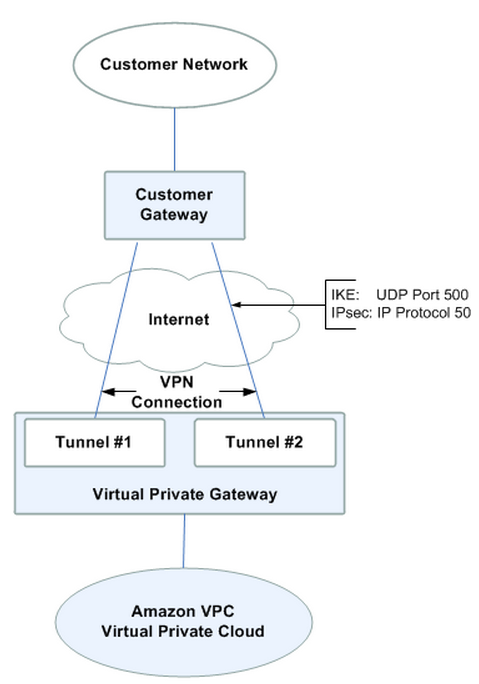
Picture source: Your Customer Gateway
Navigate to the VPC-2 dashboard in Region-2. Click on Virtual Private Gateways and then Create Virtual Private Gateway.
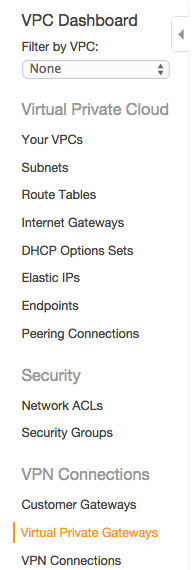

Select the virtual private gateway that we've just created and select Attach to VPC-2.


Click on Customer Gateways, and then Create Customer Gateway. In the dialogue that opens, enter the public IP address of our OpenVPN Access Server instance, with Routing set to the default value of Static.
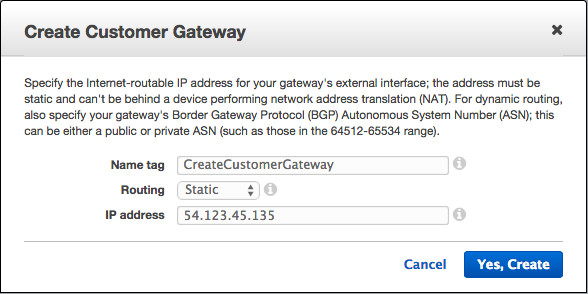

Click on Route Tables in VPC Management Console and select the routing table corresponding to our subnet(s).

Click on the Route Propagation tab and select the vgw identifier for the virtual private gateway that we created earlier, then click the Save button.


Click on the VPN Connections link at the bottom of the left frame:

Click on Create VPN Connection, and in the dialogue, select the virtual private gateway (vgw) and the customer gateway that we just created. Select Static Routing, and then enter the EIP of Open VPN Access VPN server.
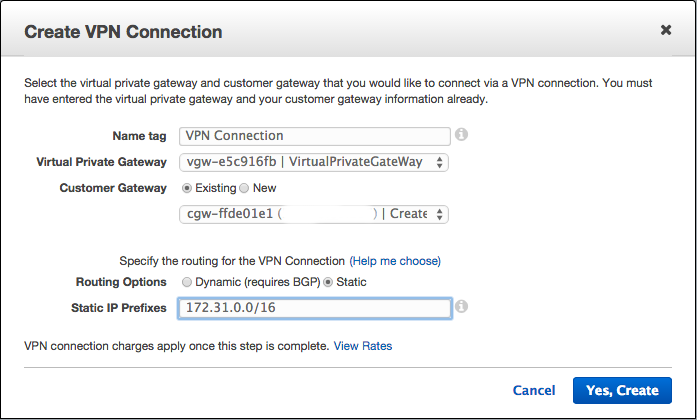
Initially, got failure notice:

After resetting Static Route:
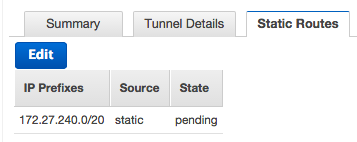
After the VPN connection has been created, the State of the connection should switch to available. As the connections have not been made yet to the VPN servers, it is perfectly normal for the icons to be red. Select the VPN connection that was created, and then note the Tunnel 1 and Tunnel 2 IP addresses below.

Click the Download Configuration button when finished.

In the Download Configuration dialog, select Generic as a vendor and then click the Yes, Download button.
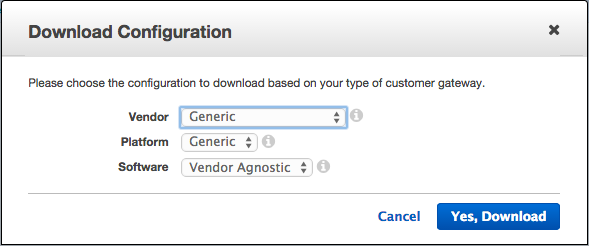
A text file should be generated that contains our pre-shared keys (PSKs).
Inside the generated file, note the two Pre-Shared Keys that are under the IPsec Tunnel #1 and IPsec Tunnel #2 sections. These PSKs correspond to the password we will be using to access the VPN connection for Tunnel 1 and 2, respectively.
Now, SSH into our OpenVPN Access Server on-premise instance and open the /etc/ipsec.conf file with a text editor. Once opened, change the rightsubnet= to the VPC CIDR mask. (consult the our VPCs section of the VPC Management Console). Under the VPC-CUST-GW1 and VPC-CUST-GW2 sections respectively, change the right= IPs to the Tunnel 1 and 2 IPs you we noted above. In our case, the proper configuration would look like the following:
AWS (Amazon Web Services)
- AWS : EKS (Elastic Container Service for Kubernetes)
- AWS : Creating a snapshot (cloning an image)
- AWS : Attaching Amazon EBS volume to an instance
- AWS : Adding swap space to an attached volume via mkswap and swapon
- AWS : Creating an EC2 instance and attaching Amazon EBS volume to the instance using Python boto module with User data
- AWS : Creating an instance to a new region by copying an AMI
- AWS : S3 (Simple Storage Service) 1
- AWS : S3 (Simple Storage Service) 2 - Creating and Deleting a Bucket
- AWS : S3 (Simple Storage Service) 3 - Bucket Versioning
- AWS : S3 (Simple Storage Service) 4 - Uploading a large file
- AWS : S3 (Simple Storage Service) 5 - Uploading folders/files recursively
- AWS : S3 (Simple Storage Service) 6 - Bucket Policy for File/Folder View/Download
- AWS : S3 (Simple Storage Service) 7 - How to Copy or Move Objects from one region to another
- AWS : S3 (Simple Storage Service) 8 - Archiving S3 Data to Glacier
- AWS : Creating a CloudFront distribution with an Amazon S3 origin
- AWS : Creating VPC with CloudFormation
- AWS : WAF (Web Application Firewall) with preconfigured CloudFormation template and Web ACL for CloudFront distribution
- AWS : CloudWatch & Logs with Lambda Function / S3
- AWS : Lambda Serverless Computing with EC2, CloudWatch Alarm, SNS
- AWS : Lambda and SNS - cross account
- AWS : CLI (Command Line Interface)
- AWS : CLI (ECS with ALB & autoscaling)
- AWS : ECS with cloudformation and json task definition
- AWS Application Load Balancer (ALB) and ECS with Flask app
- AWS : Load Balancing with HAProxy (High Availability Proxy)
- AWS : VirtualBox on EC2
- AWS : NTP setup on EC2
- AWS: jq with AWS
- AWS & OpenSSL : Creating / Installing a Server SSL Certificate
- AWS : OpenVPN Access Server 2 Install
- AWS : VPC (Virtual Private Cloud) 1 - netmask, subnets, default gateway, and CIDR
- AWS : VPC (Virtual Private Cloud) 2 - VPC Wizard
- AWS : VPC (Virtual Private Cloud) 3 - VPC Wizard with NAT
- DevOps / Sys Admin Q & A (VI) - AWS VPC setup (public/private subnets with NAT)
- AWS - OpenVPN Protocols : PPTP, L2TP/IPsec, and OpenVPN
- AWS : Autoscaling group (ASG)
- AWS : Setting up Autoscaling Alarms and Notifications via CLI and Cloudformation
- AWS : Adding a SSH User Account on Linux Instance
- AWS : Windows Servers - Remote Desktop Connections using RDP
- AWS : Scheduled stopping and starting an instance - python & cron
- AWS : Detecting stopped instance and sending an alert email using Mandrill smtp
- AWS : Elastic Beanstalk with NodeJS
- AWS : Elastic Beanstalk Inplace/Rolling Blue/Green Deploy
- AWS : Identity and Access Management (IAM) Roles for Amazon EC2
- AWS : Identity and Access Management (IAM) Policies, sts AssumeRole, and delegate access across AWS accounts
- AWS : Identity and Access Management (IAM) sts assume role via aws cli2
- AWS : Creating IAM Roles and associating them with EC2 Instances in CloudFormation
- AWS Identity and Access Management (IAM) Roles, SSO(Single Sign On), SAML(Security Assertion Markup Language), IdP(identity provider), STS(Security Token Service), and ADFS(Active Directory Federation Services)
- AWS : Amazon Route 53
- AWS : Amazon Route 53 - DNS (Domain Name Server) setup
- AWS : Amazon Route 53 - subdomain setup and virtual host on Nginx
- AWS Amazon Route 53 : Private Hosted Zone
- AWS : SNS (Simple Notification Service) example with ELB and CloudWatch
- AWS : Lambda with AWS CloudTrail
- AWS : SQS (Simple Queue Service) with NodeJS and AWS SDK
- AWS : Redshift data warehouse
- AWS : CloudFormation
- AWS : CloudFormation Bootstrap UserData/Metadata
- AWS : CloudFormation - Creating an ASG with rolling update
- AWS : Cloudformation Cross-stack reference
- AWS : OpsWorks
- AWS : Network Load Balancer (NLB) with Autoscaling group (ASG)
- AWS CodeDeploy : Deploy an Application from GitHub
- AWS EC2 Container Service (ECS)
- AWS EC2 Container Service (ECS) II
- AWS Hello World Lambda Function
- AWS Lambda Function Q & A
- AWS Node.js Lambda Function & API Gateway
- AWS API Gateway endpoint invoking Lambda function
- AWS API Gateway invoking Lambda function with Terraform
- AWS API Gateway invoking Lambda function with Terraform - Lambda Container
- Amazon Kinesis Streams
- AWS: Kinesis Data Firehose with Lambda and ElasticSearch
- Amazon DynamoDB
- Amazon DynamoDB with Lambda and CloudWatch
- Loading DynamoDB stream to AWS Elasticsearch service with Lambda
- Amazon ML (Machine Learning)
- Simple Systems Manager (SSM)
- AWS : RDS Connecting to a DB Instance Running the SQL Server Database Engine
- AWS : RDS Importing and Exporting SQL Server Data
- AWS : RDS PostgreSQL & pgAdmin III
- AWS : RDS PostgreSQL 2 - Creating/Deleting a Table
- AWS : MySQL Replication : Master-slave
- AWS : MySQL backup & restore
- AWS RDS : Cross-Region Read Replicas for MySQL and Snapshots for PostgreSQL
- AWS : Restoring Postgres on EC2 instance from S3 backup
- AWS : Q & A
- AWS : Security
- AWS : Security groups vs. network ACLs
- AWS : Scaling-Up
- AWS : Networking
- AWS : Single Sign-on (SSO) with Okta
- AWS : JIT (Just-in-Time) with Okta
Ph.D. / Golden Gate Ave, San Francisco / Seoul National Univ / Carnegie Mellon / UC Berkeley / DevOps / Deep Learning / Visualization